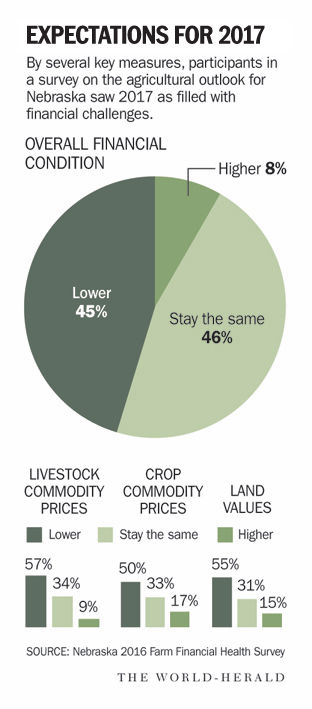After a year of plunging prices and profits, Nebraska farmers face ‘tough choices’ in 2017
By Barbara Soderlin / World-Herald staff writer

Matt Haney/The World-Herald
The 2016 harvest is in the bins, and Nebraska farmers now turn their attention to rows of figures.
With economic clouds on the horizon, they’ll spend the winter crunching numbers and making decisions about how to finance their businesses and households after a year of falling prices and profits. The decisions have implications for the state budget and for banks and retailers in cities statewide.
“There are some people out there who are going to have to make some tough choices,” said Jay Parsons, Nebraska Extension economist.
Those choices include what to plant, whether they can get enough of an operating loan, how to refinance debt, even whether to keep farming some or all of their land, Parsons and other farm finance experts said Friday in Lincoln.
The event was the fourth and final meeting of the annual Cornhusker Economics Outlook tour, after similar stops in Kearney, Sidney and Norfolk.
The meeting closed out a week that had brought new evidence of the ongoing downturn for farmers.
The U.S. Department of Agriculture cut its forecast for net farm income, saying farm profit will drop for the third straight year in 2016, to its lowest level since 2009. Farm profit is expected to fall 17.2 percent to $66.9 billion. The industry saw record profit in 2013, of $123.7 billion.
Nebraska’s farm profits will see a similar plunge, to just over $4 billion from about $4.9 billion in 2015, University of Nebraska-Lincoln ag economics professor Brad Lubben said. The state saw highs of about $7.5 billion in farm profits in 2011 and 2013.
A huge corn harvest and big supplies of meat are driving down prices for livestock and crop producers.
 Farmers know they are in for ups and downs, and the problem is not that the new forecasts for profit are so low historically, Lubben said; it’s that they are such a shock after the record highs, and require big adjustment for producers.
Farmers know they are in for ups and downs, and the problem is not that the new forecasts for profit are so low historically, Lubben said; it’s that they are such a shock after the record highs, and require big adjustment for producers.
Ag Secretary Tom Vilsack said government farm safety net programs will help provide financial stability for producers. Farm Bill program payments are expected to rise 19.1 percent to $12.9 billion. Payments in Nebraska won’t be markedly up in 2016 compared with 2015, Lubben said.
How will typical farm households fare? Many will lose money on farming this year: Median U.S. farm income earned by these households will be negative, at minus $1,412, with slightly more than half of farm households losing money on farming operations, the USDA said.
Most of these families earn money in other jobs. Median farm household income will be unchanged this year at $76,839, the USDA said.
Median numbers belie extreme variability among farm families, said Tina Barrett, executive director of Nebraska Farm Business, which helps farmers with accounting and budgeting. For many operations, debt is increasing rapidly, and there is little cash to pay family living costs.
“We have a cash-flow problem,” she said. “We don’t have an equity problem.”
She advises farmers to take a hard look at budgeting and be strict about luxury expenses, whether a too-big house, trips or brand-name clothes. Even in farm country, appearances matter, and Barrett said there’s such a thing as too much pride.
“You’re either going to look like you don’t have money or you’re going to not have money,” she said.
When it comes to farm operations, there is no one easy way to return to profitability — no banking on a huge yield or strong prices, she said.
“We’ve got to reduce every cost across the board,” Barrett said. “Can you save 10 cents for every dollar you spend? A little bit can make a big difference.”
Those are the types of decisions farmers can control, the experts said, at a time when so much seems uncertain as President-elect Donald Trump — elected thanks in part to strong support in rural Nebraska — prepares to take office. He has pledged to upend trade deals, the health insurance marketplace, environmental regulations, the tax code and more.
The uncertainty is on top of deep worry Nebraska farmers expressed in a July survey, newly published by UNL’s Department of Agricultural Economics.
More than half of the nearly 1,000 Nebraska farmers and ranchers surveyed said they have a “great amount of financial stress.”
The survey also found:
>> More than three-fourths of producers worry they won’t be able to get the operating capital they need for 2017.
>> Nearly half believe their overall financial condition will decline in 2017. Fewer than one in 10 believes it will improve.
>> Producers said they will cut costs by postponing machinery purchases and cutting family spending.
Things may be worse for younger farmers who lack equity in their operations: Four in five of those age 35 or younger said they have a great amount of financial stress.
For farmers in their early 30s, current conditions are a “wake-up call” after some good years, said Mat Habrock, assistant director at the Nebraska Department of Agriculture. He mentioned a friend, a farmer near Wayne, who scrapped a Mexican vacation for a far cheaper weekend camping across a different border: in Yankton, South Dakota.
barbara.soderlin@owh.com, 402-444-13360